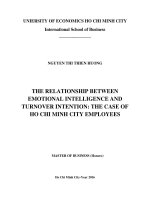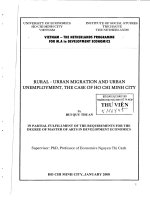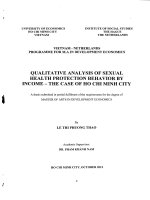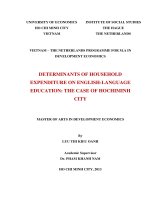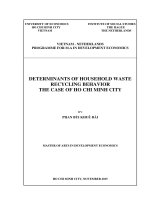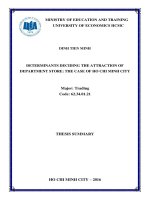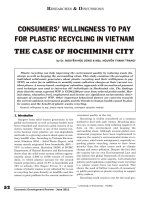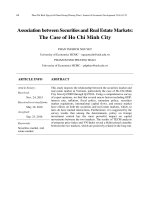Behavioral factors affecting investment decision making the case of ho chi minh stock exchange, vietnam
Bạn đang xem bản rút gọn của tài liệu. Xem và tải ngay bản đầy đủ của tài liệu tại đây (1.35 MB, 103 trang )
MINISTRY OF EDUCATION TRAINING
UNIVERSITY OF ECONOMICS HO CHI MINH CITY
INTERNATIONAL SCHOOL OF BUSINESS
-------------------------------
MASTER THESIS
BEHAVIORAL FACTORS AFFECTING INVESTMENT DECISION- MAKING.
THE CASE OF HO CHI MINH STOCK EXCHANGE (HOSE), VIETNAM.
Student: Phung Thai Minh Trang
Course: MBUS 2.2
Instructor: Dr. Dinh Cong Khai
Ho Chi Minh City, 2013
ACKNOWLEDGEMENTS
This research would not have been possible without the valuable contribution
of many people. I would like to take this opportunity to express my great gratitude for
their understanding, encouragement, and support.
First, I would like to extend my deepest appreciation to my thesis supervisor,
Doctor Dinh Cong Khai, for his numerous valuable comments and suggestions. I am
very fortunate to have his supervision and his continuous encouragement which has
motivated me and gave me confidence to complete this research.
In addition, I would like to thank all of the directors and lecturers of ISB for
providing me a solid foundation of knowledge, which has been not only useful for this
research work but also for my future development in my social life and my
professional career.
A special “thank you” to my classmates and friends for providing me with
their honest and candid comments on my questionnaire as well as instant support
regardless if day or night. All of this contributed to the succcess and the quality of the
research.
Furthermore, I want to express my appreciation to the managers and
employees working at the Ho Chi Minh Stock Exchange and various securities
companies, who helped me arrange the interviews and helped in the distribution of the
questionnaires. I am also thankful to the beneficiary investors who participated in the
interviews and the survey.
Finally, it would be impossible to say enough about my dear parents and
husband for all of their understanding, encouragement, and advice which helped me to
overcome the most difficult times in order to complete this research in time.
Phung Thai Minh Trang
Page: i
EXECUTIVE SUMMARY
Although finance has been studied for a long time, behavioral finance, which
encompasses human behaviors in finance, is a fairly new area. Behavioral finance
theories, which are based on human psychology, attempt to understand how emotions
and cognitive errors influence individual investors‟ behaviors (investors mentioned in
this study are referred to as individual investors).
The main objective of this study is the exploring of the behavioral factors
influencing individual investors‟ decisions at the Ho Chi Minh Stock Exchange.
Furthermore, it is related to relations between these factors and the results that they
achieve. Since there are limited studies about behavioral finance in Vietnam, this
study is expected to significantly contribute to the development of this type of
research in Vietnam.
The study begins with the existing theories in behavioral finance, based on
which, hypotheses are proposed. Then, these hypotheses are tested through the
questionnaires distributed to individual investors at the Ho Chi Minh Stock Exchange.
The collected data is then analyzed by using SPSS software. Questions of the
interviews with some managers of the Ho Chi Minh Stock Exchange are conducted to
achieve a deeper understanding of these behaviors. The results showed that there were
three behavioral factors affecting the investment decisions of individual investors at
the Ho Chi Minh Stock Exchange including representativeness, gambler‟s fallacy and
over-under reaction. Representativeness and over-under reaction had positive impacts
on investors‟ investment decision making, whereas gambler‟s fallacy had negative
impacts. Additionally, the behavioral factor of representativeness positively
influenced the investment decision at the highest level. The results also presented that
three behavioral factors did not affect investment decision including availability bias,
Page: ii
mental accounting bias and herd behavior. In addition, the paper gave some
implications of study such as preference of investors for buying blue chip stocks,
midcap and penny stocks as well, avoiding buying stocks with poor performance in
the recent past or useful lessons of stock fluctuation, etc. Moreover, the paper also
gave recommendation for individual investors in using behavioral factors with an
acceptable level in order to bring good investment results. Finally, it mentions
limitation s, colclusion as well as further research.
Page: iii
TABLE OF CONTENTS
ACKNOWLEDGEMENT .......................................................................................................i
EXECUTIVE SUMMARY ................................................................................................... ii
TABLE OF CONTENTS ......................................................................................................iv
LIST OF TABLES ................................................................................................................ vii
LIST OF ABBREVIATION................................................................................................ viii
CHAPTER 1: INTRODUCTION……… .................................................................................. 1
1.1. Research background ................................................................................................... 1
1.2 Problem of statement ..................................................................................................... 2
1.3 Research questions ......................................................................................................... 5
1.4 Research scope ............................................................................................................... 5
1.5 Research method ............................................................................................................ 6
1.6 Significance of the research........................................................................................... 6
1.7 Structure of the study .................................................................................................... 7
CHAPTER 2: LITERATURE REVIEW ............................................................................... 9
2.1 Classical finance theory versus behavioral finance..................................................... 9
2.2 Review some behavioral factors impacting on the process of investors’ decision
making................................................................................................................................. 10
2.2.1 Representativeness .................................................................................................. 11
2.2.2 Availability bias ...................................................................................................... 11
2.2.3 Gambler’s fallacy.................................................................................................... 12
2.2.4 Herd behavior: buying and selling decisions ......................................................... 12
2.2.5 Mental accounting .................................................................................................. 13
2.2.6 Over and under-reaction......................................................................................... 13
2.4. Suggested research model .......................................................................................... 16
2.5. Research model ........................................................................................................... 20
CHAPTER 3: RESEARCH METHODOLOGY ................................................................ 21
3.1 Research design ............................................................................................................ 21
3.1.1 Research methods ................................................................................................... 21
3.1.2 Research process ..................................................................................................... 22
3.1.3 Sample size ............................................................................................................. 22
3.2 Adjusted research model ............................................................................................. 23
3.3 Scales measurement design ......................................................................................... 25
3.3.1 Scales measurement of Representative bias............................................................ 26
3.3.2 Scales measurement of mental accounting bias ...................................................... 27
Page: iv
3.3.3 Scales measurement of gambler‟s fallacy ............................................................... 27
3.3.4 Scales measurement of availability bias ................................................................. 28
3.3.5 Scales measurement of herd behavior ..................................................................... 29
3.3.6 Scales measurement of over-underreaction ............................................................ 30
3.3.7 Scales measurement of investment decision ........................................................... 31
3.4 Data analysis approach................................................................................................ 32
3.4.1 Test of scales measurement reliability .................................................................... 32
3.4.2 Exploration factor analysis (EFA) .......................................................................... 33
CHAPTER 4: DATA ANALYSIS AND FINDINGS .......................................................... 35
4.1 Data description ........................................................................................................... 35
4.2 Factor analysis of behavioral variables influencing the individual investment
decisions .............................................................................................................................. 36
4.2.1 Pilot survey (N=52)................................................................................................. 36
4.2.2 Results of Cronbach‟s alpha analysis of pilot survey (N=52)................................. 36
4.2.3 Results of Cronbach‟s alpha analysis of official survey (N=220) .......................... 37
4.2.4 Factor analysis (EFA) ............................................................................................. 39
4.3 Regression analysis ...................................................................................................... 42
4.3.1 Results of regression analysis ................................................................................. 43
4.3.2 Test of assumptions................................................................................................. 46
CHAPTER 5: RECOMMENDATION AND CONCLUSION .......................................... 48
5.1
Implications of the study ....................................................................................... 48
5.2
Recommendations for individual investors at the HOSE ................................... 52
5.3
Limitations of the study ......................................................................................... 53
5.4. Conclusion ................................................................................................................... 54
5.5. Further research ......................................................................................................... 55
Appendix 5.1 ........................................................................................................................... 63
Appendix 5.2 ........................................................................................................................... 70
Appendix 5.3 ........................................................................................................................... 73
Appendix 5.4 ........................................................................................................................... 80
Appendix 5.5 ........................................................................................................................... 81
Appendix 5.6 ........................................................................................................................... 90
Appendix 5.7 ........................................................................................................................... 91
Page: v
LIST OF TABLES
Table 1: The highest and lowest VN-index from 2000 to 2012................................... 2
Table 2.1: Summarizing results of researches of behavioral factors .......................... 17
Table 3.1: Items of Representative ............................................................................ 26
Table 3.2: Items of mental accounting bias .............................................................. 28
Table 3.3: Items of gambler‟s fallacy ....................................................................... 29
Table 3.4: Items of availability bias ......................................................................... 30
Table 3.5: Items of herd behavior ............................................................................ 32
Table 3.6: Items of over-underreaction .................................................................... 36
Table 3.7: Items of investment decision ................................................................... 33
Table 4.1: Idependent variables, dependent variables and items ............................... 38
Table 4.2: Cronabach‟s alpha test of items (N=52)................................................... 39
Table 4.3: Cronbach‟s alpha test of items (N=220) .................................................. 40
Table 4.4: KMO and Bartlett‟s Test, total variance explained and rotated component
matrix. (EFA time 1) ........................................................................................... 42
Table 4.5: Summary of KMO and Bartlett‟s Test, total variance explained and rotated
component matrix. (EFA time 2) ......................................................................... 43
Table 4.6: Rotated component matrix. (EFA time 2) ................................................ 44
Table 4.7: summary of grouped items ...................................................................... 45
Table 4.8: Means, Standard Deviations, and Intercorrelations of RETURN and
Predictor Variables .............................................................................................. 46
Table 4.9: Simultaneous Multiple Regression Analysis Summary ............................ 54
Table 4.10: Results of hypothesis test ...................................................................... 56
Table 2.2: Summarizing researchers studying behavioral factors that impacts
investment decision making ................................................................................ 95
Page: vi
LIST OF ABBREVIATION
EFA
: Exploratory Factor Analysis
HOSE
: Ho Chi Minh Stock Exchange
HAS
: Ha Noi Stock Exchange
SPSS
: Statistical Package for the Social Sciences
VN-Index
: Vietnam Index of Stock Price
Page: vii
CHAPTER 1: INTRODUCTION
1.1. Research background
The Vietnamese stock market was established in 1998. It consists of the Ho
Chi Minh City stock exchange (HOSE) and the Ha Noi stock market (HAS). At the
first stage, in 2000, the Vietnam stock market had only 2 listed companies and 4
security companies. However, after more than ten years, there are currently 682
member securities companies. These mark the development of the Vietnamese stock
market in general and the HOSE specifically. Starting at 100 points in July 2000, after
one year in operation in June, 2001, the VN-Index had increased fivefold and reached
a peak at 571 points. Investors were overly excited and dreamed of earning quick
money as demand rose significantly even though there were only a few listed stocks
on the stock exchange. However, it was lack of knowledge and trading experience of
investors as well as the insufficient support from the authorities that made the VNIndex to suddenly unceasingly fall until it reached the bottom at 139 points in March
2003 (Huy, 2010). Investors who joined the market during this period and who were
not able to jump out quickly had to face severe financial difficulties due to the huge
loss of assets. The stock market then seemed to go into a hibernative status until 2005
and finally “woke up” in 2006. The boom started in the second half of 2006 and the
stock market rocketed up to 1170 points by March 2007. It fluctuated around the 1000
point mark until October, 2007. The Ho Chi Minh stock market had never been
“hotter” than at that time. However, VN-Index went again into a decline stage after
being pushed up to the peak. The Ho Chi Minh stock market experienced a gloomy
year in 2008 and VN-Index only stopped decreasing in February 2009 at 245 points.
Economic experts and analysis explained the sharp decline of the VN-Index that was
affected by various factors such as the tightening of monetary policies, especially the
1
lending for stock investment, high deposit interest rates, high inflation rates, and a
recession in the United States economy. Lack of timely intervention by the authorities
was also a reason why VN-Index fell so dramatically (Vo and Pham, 2008, p.15).
From 2009 to the first quarter of 2011, VN-Index continued to undergo many upsand-downs: reaching another peak at 542 points in May 2010, another bottom at 351
points in November, 2010. However, it seemed to fluctuate around 400-500 points
and no significant amplitude was found in 2012.
Table 1: The highest and lowest VN-index from 2000 to 2012
Year
2000-2005
Highest prices
Lowest prices
571.04 (2001)
132.7 (2004)
2006
591.4
439.6
2007
1170.67
883.9
2008-2009
921.07 (2008)
244.4 (2009)
2010-2011
542 (5/2010)
350.5 (2011)
490
335
2012
(Source: www.cafef.vn)
1.2 Problem of statement
During twelve years, the HOSE specifically and the Vietnamese Stock
exchange in general went through many different stages. Its prices fluctuated, up and
down, and it seemed to be difficult for investors to make sound investment decisions.
Especially, with the boom of VN-Index 2007, the Vietnam Stock Market was
negatively impacted by foreign newspapers. The Financial Times showed that the
HOSE was a „too hot place‟ and overstated its value. The AMCHAM (The American
Chamber of Commerce) declared that the Vietnam stock market‟s growth was
impractical, just another case of a „bubble market‟.
2
The Efficient Markets Hypothesis (EMH) could not explain causes leading to
this bubble market because EMH is referred to as “the notion that stocks already
reflect all available information” (Bodie, Kane & Marcus, 2008, p. 359) and capital
markets are informationally efficient (Fama, 1998, p 383 – 417). Meanwhile,
behavioral finance assumes that, in some circumstances, financial markets are
informationally inefficient (Ritter, 2003, p 429 – 437) and factors of behavioral
finance could be considered in the situation of bubble market (Waweru et al, 2008,
p.25).
Behavioral finance can be helpful in the bubble market because it is based on
the psychology to explain why people buy or sell stocks (Waweru et al., 2008, p.25).
Behavioral factors include overconfidence, representativeness, availability, herding,
loss aversion, regret aversion, gambler‟s fallacy, over-underreaction, etc (Ritter, 2003,
p 437). Many researchers consider behavioral finance as a good theory to understand
and explain feelings and cognitive errors affecting investment decision-making
(Waweru et al., 2008, p.25). Supporters of behavioral finance believe that the study of
social sciences such as psychology can help to reveal the behaviors of stock markets,
market bubbles and crashes. As shown below:
In Europe, Johnsson, Andrén, Lindblom & Platan (2002) reported results of
behavioral factors of individual investor and institutional investors in Sweden that
positively impact on their investment decision. It is accepted that 67% of the total
amount of individual investors are influenced by the factor of loss aversion bias, 33%
of the total number of investors are impacted by the factor of representative bias, 32%
of total amount of investors are controlled by the factor of regret aversion bias, etc.
Besides European countries, behavioral finance is also discovered in Asia.
Chandra, Abhiject and Kumar, Ravinder (2011) research determinants of individual
3
investor behavior in the Indian stock market that have influence on their investment
decisions and results as follows: Representativeness bias with strong existence,
Overconfidence bias that investors tend to have too much confidence in the accuracy
of their own judgments, 53,2% of total number of investors are controlled by the
factor of anchoring, 35,5% of total amount of participants are affected by the factor of
gambler‟s fallacy on their investment decision. 57,7% of total amount of investors are
impacted by the factor of availability bias. And 55% of total numbers of investors are
influenced by the factor of loss aversion bias on their decision, etc.
In addition, Vuong & Dao (2012) discover individual investors‟ behavioral
biases in the Vietnamese stock market; namely, there are 51,2% of the total number
of investors are influenced by the factor of regret aversion bias on their investment
decision. 47,7% of the total amount of investors are impacted by the factor of loss
aversion bias on their investment decision. Similarly, the factor of anchoring
bias:43%, the factor of overconfidence bias (42,4%) the factor of self-control bias
(42.4%), illusion of control bias (41.3%), confirmation bias (41.3%), framing bias
(34.9%), conservatism bias with 30.3%, representative bias with 18% and 17.4% of
the total amount of investors are affected by the factor of availability bias.
There are two reasons why behavioral finance is important and interesting
when applied to the Vietnamese stock market - HOSE. First, behavioral finance is still
a new topic for study. Until recently, it is accepted as a feasible model to explain how
investors of financial markets make decisions and then how these decisions influence
the financial markets (Kim and Nofsinger, 2008, p.1). Secondly, due to some
evidence such as subjective, academic, and experimental, it is concluded that Asian
investors, included are the Vietnamese, usually suffer from cognitive biases more than
people from other cultures (Kim and Nofsinger, 2008, p.1). Therefore, the
4
consideration of the factors influencing the Vietnamese investors‟ decision-making
process cannot ignore the behavioral elements. This study hopes to enrich the number
of studies using behavioral finance for making investment decisions by Vietnamese
investors in the stock market.
1.3 Research questions
The paper identifies behavioral factors influencing investment decisionmaking of individual investors at the HOSE. Additionaly, the paper also identifies
impact levels of behavioral factors on the investment decision-making of individual
investors at the HOSE. The paper designs research questions as follows:
1/ What are the behavioral factors influencing individual investors‟ decisions
at the HOSE?
2/ How strong is impact of behavioral factors on investment decision making
of individual investors at the HOSE?
1.4 Research scope
There are only two stock exchanges in Vietnam; one is in the Ha Noi Capital
and one is in Ho Chi Minh City. This study focuses on the Ho Chi Minh stock
exchange because Ho Chi Minh City is the biggest and most developing city in
Vietnam. The Ho Chi Minh stock market has become the yardstick of the economy‟s
wealth and helps enterprises and investors to raise capital for their business
enterprises. Moreover, due to time limitations, choosing HOSE for this research will
help the author shorten the distance, provide more accurate survey information and
offer more effective interview data as well.
5
1.5 Research method
The paper employs both qualitative and quantitative methods. This research
process involves pilot study and official research. This pilot study is based on the
qualitative method and pilot interview. The qualitative method helps the author define
and discover the behavioral factors of investors affecting their investment decisionmaking in order to adjust and complement this official research. The pilot interview
that is performed by the direct interview approach aims to make questionnaires more
perfect before the official research. The author directly interviews 10 investors who
have more than 10 years of experience with stock investments. The quantitative
research is carried out by survey questionnaires that are sent to 220 investors who
have invested in the HOSE. First, the author sends the questionnaires to 52 investors
(pilot survey) in order to test the reliability of the measurement scales. After deleting
some questions that appear to not be relevant or reliable, the author sends the survey
questionnaire to 170 more investors.
In this study, the hypotheses can be built based on the existing behavioral
finance theories, the quantitative method is used first to test these hypotheses and then
the qualitative method is used to analyze the results with a deeper inspection. To test
the reliability of the scales measurement , the paper uses SPSS software to test
Cronbach‟s Alpha based on standardized items. After that, the paper tests scales
measurement validity: factor analysis - EFA (Exploratory Factor Analysis). Finally,
the paper applies regression for testing assumptions and hypothesis.
1.6 Significance of the research
•
Help investors or organizations consider and analyze these behavioral factors
before making decisions for investment.
•
Employ these behavioral factors effectively to increase success in business.
6
1.7 Structure of the study
Chapter 1, Introduction, mentions two parts. The first part relates to the
overview of HOSE from the initial stages of its opening to the present. The second
part involves the problem statement and gives the reasons to select the topic.
Chapter 2, Literature Review, reviews behavioral factors affecting investment
decision-making that previous researchers studied. Behavioral factors include
representativeness, availability bias, gambler‟s fallacy, herding, regret aversion, loss
aversion, etc. After that, the paper suggests studying six behavior factors such as
representativeness, availability bias, herding, gambler‟s fallacy, mental accounting
bias and over-underreaction. In addition, the paper also proposes hypothesis and
research models as well.
Chapter 3, Methodology, presents research methods: qualitative and
quantitative method. In the qualitative method, the author interviews 10 investors
about behavior factors they possess and their ideas regarding the content of the
questionnaires. After obtaining relevant and reliable questionnaires, the paper
employs the quantitative method to survey 220 investors with five Likert scales
(extremely disagree to extremely agree). Additionally, the paper also mentions
research population, samples, steps of investment decision through SPSS software.
Chapter 4, Findings, data collection and analysis, has three parts: part 1:
results of the interview and report investors‟ idea. Investors give valuable feedback
for the questionnaires and present their ideas for the behavioral factors. Part 2: results
of the pilot survey (N=52): the paper tests measurement reliability and validity
(EFA). Part 3: results of official survey (N=220): the paper tests measurement
reliability, validity (EFA) and regression and test six assumptions including
7
independence of residuals, a linear relationship, homoscedasticity of residuals, no
multicollinearity, no significant outliers or influential points and normality of the
residuals. After that, the paper reports the findings with a hypothesis.
Chapter 5, Recommendation and conclusions, first, discusses how behavioral
factors affect investors‟ decisions including representativeness, gambler‟s fallacy and
over-under reaction. Secondly, the paper mentions behavioral factors do not affect
investment decision making of individual investors encompassing availability bias,
herd behavior and mental accounting bias. Next, the paper recommends to individual
investors and limitation of the study. Finally, the paper shows a conclusion.
8
CHAPTER 2: LITERATURE REVIEW
This study reviews the literatures of behavior finance. First, it mentions the
classical finance theory versus behavioral finance. Secondly, main theories of
behavioral finance relates to the research. Finally, a research model with hypotheses is
showed.
2.1 Classical finance theory versus behavioral finance
According to Fama (1998), known as the father of efficient market hypothesis
(EMH), EMH assumes that the capital market is informationally efficient (p. 283). In
contrast, behavioral finance assumes that, in some circumstances, financial markets
are informationally inefficient (Ritter, 2003, p. 430). According to EMH, although
there are not all investors who are reasonable, the markets are proposed to be
reasonable and make unbiased forecasts. Meanwhile, behavioral finance believes that
sometimes, financial markets do not have informational efficiency (Ritter, 2003, p.
430). Additionally, Statman (1999) states that stock market efficiency has two
meanings: first, it means that there is unsystematic method to beat the market. Second,
it means that stock price are reasonable, only reflect “fundamental” or “utilitarian”
characteristic, such as risk, but not “psychological” or “value-expressive”
characteristics, such as sentiment (p. 18-27). Conversely, behavioral finance is the
psychological decision process in recognition and prediction of financial markets
(Talangi, 2004, p. 3-25). In the case of capital markets, there are three categories:
weak form efficiency, semi-strong form efficiency and strong form efficiency.
According to EMH, the weak form efficiency is distinguished by the fact that the
current price of a financial asset reflects all the historical financial information
available on the market. The semi-strong form efficiency is characterized by the fact
9
that share prices adjust to publicly available new information very rapidly and in an
unbiased manner, such that no excess returns can be earned by trading on that
information. In addition, strong form efficiency includes both semi-strong form
efficiency and weak form efficiency. Specifically, share prices reflect all information,
public and private, but none of these can earn excess returns.
With behavioral finance, Tversky and Kahneman (1979) who are recognized
as the father of behavioral finance can be best explained in different phases by their
works. (p.263). Besides, Olsen (1998) defines that it is “the new paradigm of
behavioral finance which seeks to replace the behaviorally incomplete theory of
finance now often referred to as standard or modern finance.” (p.11). In addition,
Fromlet (2001) proposes the following definition: “behavioral finance closely
combines individual behavior and market phenomena and uses knowledge taken from
both the psychological field and financial theory (p.65). Similarly, Olsen (1998) also
mentions that behavioral finance is “focused on the application of psychological and
economic principles for the improvement of financial decision making” (p.11).
In short, behavioral finance represents a revolution in financial theory. It
highlights the psychological edge of investment decision making process, in strong
contradiction to the EMH.
2.2 Review some behavioral factors impacting on the process of investors’
decision making
Many researchers studied behavioral factors affecting investment decision
making such as Representativeness, Availability bias, Anchoring, Overconfidence,
etc. The literature review is interested in behavioral factors influencing investment
decision making by individual investors as follows:
10
2.2.1 Representativeness
Representativeness describes to the level of resemblance that a thing owns with its
parent population (DeBondt & Thaler, 1995, p.390) or the degree to what things are
similar with its population (Kahneman & Tversky, 1974, p.1124). Representativeness
refers to results in some biases including investors expressing too much strength on
current experiences and regardless of the average long-term rate (Ritter, 2003, p.432).
A normal situation for representativeness is that investors deduce a business‟ high
long-term growth rate after some quarters of going up and positively affecting
investors‟ decision (Waweru et al., 2008, p.27). Additionally, representativeness also
so-called “sample size neglect” that exists as investors make an effort to draw
inferences from too few samples (Barberis & Thaler, 2003, p.1065). In the stock
exchange, when investors find out to buy “hot” stocks instead of poor company
performance, this means that representativeness is employed (Barberis & Thaler,
2003, p.1065). Particularly, in theVietnamese stock market, representative bias of
individual investors was positively 18% in 2012 (Vuong & Quan, 2012, p.9).
2.2.2 Availability bias
According to Jahanzeb, Muneer & Rehman (2012), they state that availability
bias is a cognitive bias that drives humans to overestimate the probabilities of the
events affiliated with memorable or vivid happenings and investors place excessive
weight on the most information available while making decisions (p. 534).
Additionally, in stock exchanges, availability bias appears through investors‟
preference of trading local stocks. They are familiar with local stocks because of
easily obtaining information, although the basic rules of diversification of portfolio
management are optimality (Waweru et al., 2003, p.28). In addition, Chandra,
Abhiject and Kumar, Ravinder (2011) announce that 57.7% of investors were
11
positively impacted in the Indian stock market by this factor (p.16). Meanwhile, the
percentage of investors in the Vietnamese stock market who were influenced was
positively only 17.4% (Vuong & Quan, 2012, p.9).
2.2.3 Gambler’s fallacy
As people wrongly believe that random event is less likely to occur following
an event. This is incorrect due to it is related to probability, certain events will still
occur in the future. „Law of small numbers” (Rabin, 2002, p.775; Statman, 1999,
p.20) may lead to a Gambler‟s fallacy (Barberis & Thaler, 2003, p.1065). More
specification, in the stock exchanges, Gambler‟s Fallacy appears as investors estimate
incorrectly the reverse points which are carefully thought as the end of good (or poor)
market returns (Waweru et al., 2008, p.27). In addition, when investors are subjective
to this bias, they trend to collect suboptimal replacement, simply due to it was prior
selection (Kempf and Ruenzi, 2006, p.204). Moreover, according to Chandra,
Abhiject and Kumar, Ravinder (2011), they researched that in the Indian stock
exchange, 35.5% of investors were positively influenced by this factor (p.15).
2.2.4 Herd behavior: buying and selling decisions
According to Chaudhary (2013), the author states that a herding behavior
refers to reasonable or unreasonable actions of a large group (p. 88). Investors are
usually based on selective information more than individual information to make
investment decisions. Herd behavior can help investors succeed and have a favorable
result for their investment, but may also make investors fail and have bad
consequences of their investment. Tan, Chiang, Mason & Nelling (2008) concentrate
on herding because they prove that when a stock‟s price fluctuates, viewpoints of a
large group can assist them to get profit or prevent risk (p.61). In the stock exchange,
buying stocks is based on „price momentum‟ without paying attention to law of
12
supply and demand is identified as herd behavior and leads to wrong decisions
(Chaudhary, 2013, p. 88). Moreover, Waweru et al. (2008) show that investors are
positively affected by factors such as buying, selling, investment time and a number
of stocks. Waweru et al. (2008) also present that the investment decision of an
investor is affected by decisions of other investors. However, the preference of
herding is based on the kinds of investors. For instance, according to Goodfellow,
Bohl & Gebka (2009), they expose that investment decision making of individual
investors trend to come after the crowds more than institutional investors (p.213).
2.2.5 Mental accounting
According to Barberis & Huang (2001), they state that mental accounting
refers to “the process by which people think about and evaluate their financial
transactions” (p.1248). Mental accounting permits people to manage their portfolio
into different items (Barberis & Thaler, 2003, p.1108; Ritter, 2003, p.431).
Additionally, Rockenbach (2004) studies empirically and proposes that the
relationship between separate investment possibilities is often not made as it is
valuable to arbitrage free prices (p.524). Particularly, in the Indian stock market, this
factor positively affected investors‟ decision (64.2%) in 2011 (Chandra, Abhiject and
Kumar, Ravinder, 2011, p3). Meanwhile, the influence of this factor in investment
decision making in the Vietnamese stock exchange was positively 11% in 2012
(Vuong & Quan, 2012, p.8).
2.2.6 Over and under-reaction
Normally, fluctuation of market information, basic principles of the
underlying stocks and stock price can make over and under reaction occur. This
behavioral factor highly influences investment decision making of investors.
Researchers including DeBondt & Thaler (1985) studying over reaction (p.804) and
13
Lai (2001) researching under reaction (p.215) give results that news affects
investment strategies of investors, and then positively influences their investment
decision. Besides, according to Barberis, Andrei Shleifer and Vishny (1998), authors
state that under-reaction of stock prices to news such as earnings announcements, and
over-reaction of stock prices to a series of good or bad news. Lakonishok, Shleifer e
Vishny (LSV) (1994) find out that investors over-react to stocks that had been carried
out well in the past and are hoped to perform well in the future get lower returns than
those stocks that had had poor past performance and are estimated to have a poor
future performance. Moreover, DeBondt and Thaler (1995) present that the investors
have over- or under-reaction when stock prices fluctuate or news occurs (p. 396).
Additionally, Waweru et al. (2008) also report the behavioral factors that have
positive impact on investors‟ decision making including price changes, market
information, past trends of stocks, customer preference, over-reaction to price
changes, and fundamentals of underlying stocks (p. 36).
2.3. Investment decision
From investors‟ behavioral finance, they make investment decision that can
rational or irrational and their results of investment decision will be measured by
returns they obtain. According to Lin and Swanson (2003), they apply three features
of returns including raw returns, risk-adjusted returns, and momentum-adjusted return
through five time horizons with every day, every week, every month, every quarter
and every year in order to measure their results of investment (p.208). Especially,
Oberlechner and Osler (2004) believe that investment return rate can objectively
assess investment decision and discover positive impact level of overconfidence on
the investment decision (p.1-33).
14
Besides three characteristics of return are used to appraise their performance,
the paper emphasizes positive impact of behavioral factors on investment decision of
individual investors that mentioned in each behavioral factor above. According to
Kyle and Wang (1977), they expose that the overconfident investors bring positive
results that are higher than their expectation not just in a short time but also for a long
time (p.2). Moreover, Anderson, Henker and Owen (2005) state that people who have
overconfident behavior can advantage good results (p.72) and they give a conclusion
that individual who over-under reacts with information of the stock market can get
greater profit than other people without over-under reaction (p.71). Kim and
Nofsinger (2003) also find that positive results can occur not only when investors
carefully study the past performance of buying and selling behaviors, but also in the
case of stock‟s price decreasing or increasing in multiple sessions (p.2). It also is
important when Lin and Swanson (2003) show that investors have positive
consequence in the short time and is partly controlled by short time price momentum
more than by risk-loving (p.208). Investors can obtain advantages from understanding
and performing momentum tactics encompassing buying stocks that they won in the
past and selling stocks that they lost in the past (Waweru et al., 2008, p.25).
In summary, there are many ways to measure results of investment decision.
Some researchers including Lin and Swanson (2003), Kim and Nofsinger (2003)
employ the secondary data in the stock market to assess results of investors.
Nevertheless, the paper suggests appraising results of investment decision of
individual investors through the research of Oberlechner and Osler (2004) for the
investment return rate. In more details, the rate of return is assessed by three criteria
including firstly, comparing their real return rates with expected return rates,
15
secondly, the comparison between the real return rates and the average return, finally
the satisfaction level of investment decisions.
In reality, investors feel satisfied with their own investment decision even if
their profits are not high. However, there are also some investors do not feel satisfied
with their investment decision even if their return rate is high. Therefore, these criteria
can be changed to match Vietnamese stock market when the paper applies in-depth
interview later. From the arguments above, the paper believes that behavioral factors
positively affect investment decisions.
2.4. Suggested research model
The paper studies behavioral factors of investors in HOSE, Vietnam.
Therefore it is mostly based on combining the framework of researches in Asia such
as Vuong & Dao (2012) in the HOSE and results of research by Chandra and Kumar
(2011) of the Indian Stock Exchange. The paper mentions the Indian Stock Exchange
because both Vietnam and India are in Asia. Hence, the results will be more valid by
gathering and comparing the level of behavioral factors of two countries in the same
area. This comparison helps the paper complement reasonable ideas of what
behavioral factors the paper should choose to study. As Table 2 below shows
behavioral factor of gambler‟s fallacy, there are 53.2% of Indian investors who were
affected while Vietnamese researchers have not mentioned this behavioral factor yet.
Or they have not researched the factor of representativeness in the Indian stock
market. Meanwhile, this factor was studied in the Vietnamese stock exchange. Hence,
the paper will study more of these factors. Moreover, there are some behavioral
factors that were researched in both the Indian and Vietnamese stock markets, but the
percentage of the impacted level are such large differences. For example, the factor of
availability bias influenced 57.7% of Indian investors, while in the Vietnamese stock
16
market, the figure was 17.4%. And the factor of mental accounting bias, there were
only 11% of Vietnamese investors who were impacted, whereas 64.2% of Indian
investors were affected by this factor. Therefore, these factors need to be researched
further by this paper.
Table 2.1: Results of behavioral factors affecting investment decision
making of individual investors
Behavioral factors
Percentage of affected
Percentage of affected
Indian investors
Vietnamese investors
(Chandra and Kumar,
(Vuong & Dao, 2012)
2011)
Overconfidence bias
Over 50%
42.4%
Anchoring
53.2 %
43%
Gambler‟s fallacy
35.5%
Not concerned
Availability bias
57.7%
17.4%
55%
47,7
Some evidences
51,2
64.2%
11%
Representativeness
Not concerned
18%
Herd behavior: buying and
Not concerned
Not concerned
Not concerned
Not concerned
Loss aversion bias
Regret aversion bias
Mental accounting bias
selling decisions
Over and Under – reaction
17


